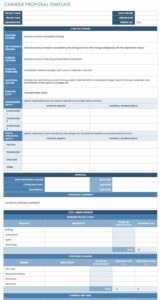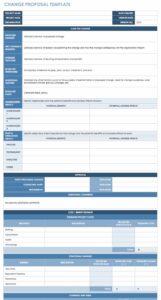Utilizing a predefined structure streamlines the change management process. Clear documentation reduces ambiguity, facilitates communication among stakeholders, and helps prevent errors. This formalized approach allows for efficient tracking, prioritization, and approval of modifications, minimizing disruption and promoting successful implementation. A well-defined process also improves collaboration between requestors, developers, and other involved parties.
The following sections delve into the specific elements of these forms, best practices for their utilization, and their integral role within a robust change management strategy.
Key Components
Effective management of system modifications requires comprehensive documentation. The following components ensure clarity and completeness in change requests.
1. Request Identifier: A unique identifier allows for easy tracking and retrieval of specific requests throughout the change management lifecycle. This ensures efficient communication and prevents confusion among stakeholders.
2. Requestor Information: Contact details of the individual or team initiating the change are crucial for clarification and follow-up. This enables efficient communication and accountability.
3. Date of Request: Timestamping the request provides context and allows for tracking of timelines and priorities within the change management process.
4. System Affected: Clear identification of the specific system targeted for modification ensures that the appropriate teams are engaged and the impact is accurately assessed.
5. Description of Change: A detailed explanation of the desired modification, including its purpose and expected outcome, is essential for understanding the scope and rationale of the request. Specific details and technical specifications should be included where applicable.
6. Justification for Change: Providing a clear rationale for the requested modification allows for proper evaluation of its necessity and potential benefits. This justification should align with business objectives and demonstrate the value of the change.
7. Priority Level: Assigning a priority level helps determine the urgency of the request and its place within the overall change management queue. This aids in efficient resource allocation and timely implementation.
8. Implementation Plan (Optional): A high-level overview of the proposed implementation steps, including timelines and resource requirements, can provide valuable context for assessing the feasibility and impact of the change. While not always required, it can significantly benefit more complex requests.
These components contribute to a well-defined request, facilitating efficient evaluation, prioritization, and implementation of system modifications. Complete and accurate information is essential for minimizing disruption and maximizing the success of system changes.
How to Create a System Change Request Template
Creating a standardized template ensures consistency and completeness in requesting system modifications. A well-designed template facilitates clear communication, efficient processing, and successful implementation of changes.
1. Define Objectives: Clearly outline the goals and purpose of the template. Determine the specific information required to effectively evaluate and process change requests within the organization.
2. Identify Key Fields: Determine the essential data points needed for each request. These fields should capture all relevant information, including request details, justification, affected systems, and priority level. Consider including fields for tracking and approval.
3. Choose a Format: Select a suitable format for the template, such as a word document, spreadsheet, or online form. The chosen format should facilitate easy completion, storage, and retrieval of requests.
4. Design the Layout: Organize the fields in a logical and intuitive manner. Use clear labels and instructions to ensure ease of understanding and completion. Consider grouping related fields for improved clarity.
5. Establish a Workflow: Define the process for submitting, reviewing, and approving change requests. Establish clear roles and responsibilities for each stage of the workflow.
6. Implement and Train: Introduce the template and associated workflow to all relevant stakeholders. Provide training on how to complete the template correctly and navigate the change management process.
7. Review and Refine: Periodically review the template’s effectiveness and gather feedback from users. Make adjustments as needed to ensure the template continues to meet evolving needs and optimize the change management process.
A well-structured template, combined with a clearly defined workflow, provides a robust framework for managing system changes effectively. This structured approach reduces errors, improves communication, and contributes to successful project outcomes.
Standardized forms for requesting system modifications provide a critical foundation for effective change management. They ensure comprehensive documentation, facilitate clear communication, and streamline the evaluation and implementation of changes. Key components such as unique identifiers, detailed descriptions, and justifications contribute to a thorough understanding of the proposed modifications. A well-defined creation process, encompassing objective setting, field identification, format selection, and workflow establishment, is essential for maximizing the template’s utility. Regular review and refinement further enhance its effectiveness.
Leveraging structured change requests enables organizations to manage system modifications efficiently, minimizing disruption and maximizing positive outcomes. This structured approach fosters collaboration, reduces errors, and contributes to continuous improvement within dynamic technological environments. Adopting such practices strengthens an organization’s ability to adapt and thrive in the face of evolving business needs and technological advancements.


